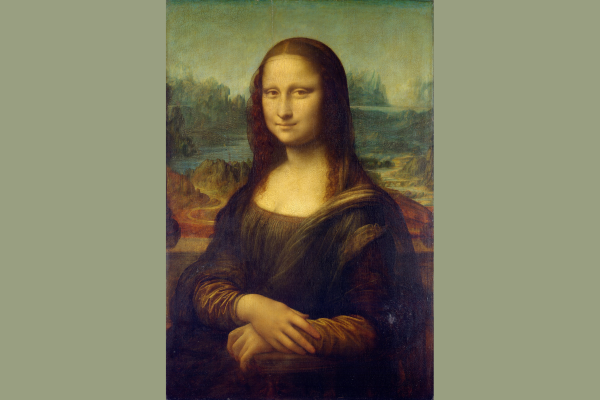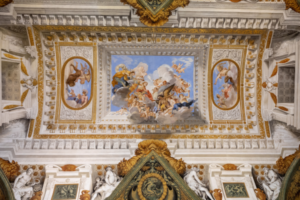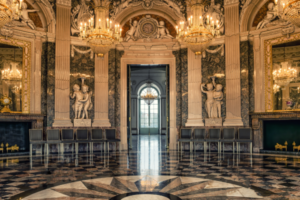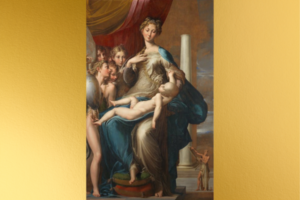The Renaissance, a fervent period of European cultural, artistic, political, and economic rebirth, emerged from the twilight of the Middle Ages, ushering in an age of renewed interest in classical learning and values. Spanning roughly from the 14th to the early 17th century, this epoch was not just an artistic movement but a cultural awakening that deeply impacted various spheres of life, from literature to science, from politics to religion.
At the heart of this monumental shift was Italy. Blessed with the ruins of ancient Rome and the memory of the Roman Empire, Italy served as the fertile ground from which the seeds of the Renaissance sprouted. Its city-states, notably Florence, Venice, and Rome, became the epicenters of this artistic and intellectual explosion. The confluence of wealth, patronage, and a rich tapestry of classical influences made Italy not just a participant, but the leading actor in this grand theater of human achievement.
In the pages that follow, we will delve into the role of one particular genius who stood head and shoulders above many during this period: Leonardo da Vinci. His works and innovations serve as a testament to the transformative power of the Renaissance and Italy’s unmatched contribution to it. But first, let us journey through the broader landscape of the Renaissance, understanding its origins, its evolution, and the indelible marks it left on the canvas of history.
Historical Context
The tapestry of the Renaissance, with its intricate designs and colorful patterns, finds its roots primarily in Italy. To understand this era of rejuvenation, one must first recognize the unique set of circumstances that gave birth to it.
Origins of the Renaissance in Italy
Italy, during the late Middle Ages, was not a unified country, but rather a mosaic of city-states, each with its own rulers, cultures, and competitive ambitions. These city-states were prosperous trade hubs, and their affluence played a pivotal role in fueling the Renaissance. With the decline of feudalism and the rise of these urban centers, there was a shift from a primarily agrarian economy to one based on commerce and trade. This economic prosperity led to the emergence of a class of wealthy merchants and bankers who became influential patrons of the arts.
Yet, the economic factors alone cannot explain the artistic and intellectual eruption. Italy’s geographical location, serving as a bridge between the East and West, made it a melting pot of ideas. The remnants of the Roman Empire and its classical literature, architecture, and art, coupled with the translations of Greek and Arabic works that reached Italian shores, ignited an intense fascination with antiquity.
Socio-political and Cultural Motivations
These city-states, while competing for dominance, also vied for cultural supremacy. The intense rivalries led to significant patronage of artists and thinkers, as rulers and wealthy families sought to use art and architecture to showcase their power, influence, and enlightened thinking.
The fall of Constantinople in 1453 brought an influx of Greek scholars to Italy, further reinforcing the study of ancient texts and philosophies. Moreover, the spirit of humanism emerged as a dominant force, focusing on individual potential and achievements. This cultural shift promoted the idea that man was capable of great feats, not just in service to God, but in various fields of art, science, and literature.
Renowned Artists of the Period
While Leonardo da Vinci stands as a titan of this age, he was but one star in a constellation of brilliance. Michelangelo’s sculptural masterpieces and Sistine Chapel frescoes revolutionized visual art. Raphael, with his harmonious compositions, brought a refined elegance to his subjects. Titian’s use of color and texture set him apart, influencing countless artists in the centuries that followed. And beyond the visual arts, figures like Dante Alighieri, Petrarch, and Boccaccio laid the groundwork for literary Renaissance, each contributing distinct voices to this chorus of creativity.
In essence, the Renaissance, birthed in the heart of Italy, was a harmonious blend of past influences and contemporary innovations, socio-political aspirations, and boundless human creativity. As we delve deeper into this era, the figure of Leonardo da Vinci emerges as an embodiment of this dynamic interplay of history, culture, and genius.
Leonardo da Vinci: The Renaissance Polymath
In the constellation of Renaissance brilliance, Leonardo da Vinci shone as perhaps its brightest star. His life and oeuvre encapsulate the very spirit of the age, pushing the boundaries of what one man could achieve within a single lifetime.
Introduction to the Life and Works of Leonardo da Vinci
Born in 1452 in the Tuscan town of Vinci, Leonardo was an illegitimate child, a fact that may have influenced his unconventional education and path in life. Rather than being bound by traditional scholastic education, Leonardo was free to pursue his diverse interests, leading him to apprenticeships that nurtured his insatiable curiosity and formidable talents.
Leonardo’s artistic genius was evident early in his life, leading him to the workshop of the esteemed Florentine artist, Andrea del Verrocchio. Here, his talent was not just recognized but also honed. He quickly surpassed his master, setting forth on a journey that would see him creating some of the most iconic works of art, such as the “Mona Lisa” and “The Last Supper.”
His Multifaceted Legacy: Artist, Scientist, Engineer, and Inventor
While most renowned for his art, Leonardo’s genius wasn’t confined to canvas and paint. He epitomized the Renaissance man, blurring the lines between disciplines.
As a scientist, Leonardo’s observations of the world around him were meticulous and analytical. His anatomical sketches, derived from personal dissections, revealed a deep understanding and reverence for the complexities of the human body, offering insights that were centuries ahead of their time.
His engineering and inventive prowess are showcased in his notebooks, filled with sketches of machines, from early prototypes of the helicopter to intricate mechanical tools. These designs, though not all realized in his lifetime, exemplified his forward-thinking and insatiable desire to understand and improve the world around him.
Da Vinci’s Importance as the “Uomo Universale” (Universal Man)
Leonardo da Vinci embodied the concept of the “uomo universale,” a term that came to define the ideal Renaissance individual. This notion celebrated the union of art and science, encouraging the belief that humans could attain expertise in multiple disciplines. Leonardo didn’t just espouse this ideal; he lived it. His life is a testament to the boundless capabilities of the human spirit when driven by curiosity, passion, and dedication.
In Leonardo, we witness a man who, in his relentless pursuit of knowledge and beauty, transcended the confines of his time, leaving an indelible mark on history. He remains a symbol of the Renaissance’s aspirations and achievements, exemplifying the era’s conviction that humanity, armed with knowledge and creativity, could reshape the boundaries of possibility.
Da Vinci’s Masterpieces that Revolutionized Art
Leonardo da Vinci, with his insatiable curiosity and unparalleled skill, produced works of art that not only defined the Renaissance but also laid the groundwork for subsequent generations of artists. Among his many masterpieces, “The Last Supper” stands as a testimony to his genius, his innovative approach, and his ability to breathe life into religious narratives.
“The Last Supper”
Description and Historical Context of the Piece:
Set in the refectory of the Convent of Santa Maria delle Grazie in Milan, “The Last Supper” depicts the moment Jesus Christ announces that one of his disciples will betray him. Leonardo masterfully captures the emotional turmoil and varied reactions among the apostles. The composition, spanning over 15 feet high and 29 feet wide, draws the viewer directly to the central figure of Christ, using perspective and positioning to ensure he remains the focal point.
This monumental mural was commissioned as part of a renovation project by Leonardo’s patron, Ludovico Sforza, the Duke of Milan. Painted between 1495 and 1498, “The Last Supper” was not just another religious painting; it was a reflection of both religious reverence and the Renaissance’s humanistic ideals.
Techniques and Innovations Introduced:
Use of Perspective: Leonardo employed linear perspective to create depth and dimension on a flat surface. The orthogonal lines converge at a single vanishing point – Christ’s head, reinforcing his significance and drawing the viewer’s attention to the crux of the narrative.
Study of Human Emotion: Rather than a static representation, Leonardo showcased the varied emotional reactions of the disciples, making it a study in human psychology. The arrangement of the apostles in groups of three allows the viewer to witness the myriad of responses to Christ’s revelation, from shock to confusion to contemplation.
Experimental Materials: Leonardo chose to forgo traditional fresco techniques, which required fast work on wet plaster. Instead, he opted for a technique that allowed him to work slowly, applying layers of tempera and oil paint on a primed wall. This decision, while innovative, contributed to the mural’s fragility and subsequent deterioration over time.
Chiaroscuro: Leonardo’s play with light and shadow, known as chiaroscuro, added depth and volume to the figures, creating a three-dimensional illusion on a two-dimensional surface. This technique amplified the drama and emotional intensity of the scene.
In “The Last Supper,” Leonardo da Vinci not only showcased his masterful techniques but also introduced a new narrative style in religious art. The mural, with its intricate details, emotional depth, and groundbreaking techniques, remains one of the most revered and studied artworks in history, epitomizing the zenith of Renaissance art and Leonardo’s indomitable genius.
The Technical and Artistic Innovations of Da Vinci
Throughout his artistic journey, Leonardo da Vinci not only crafted aesthetically stunning masterpieces but also introduced technical innovations that revolutionized the world of art. His commitment to accuracy, detailed observation, and experimentation elevated Renaissance art to new heights.
The sfumato technique and its influence on realistic portrayal:
The term “sfumato,” derived from the Italian word “sfumare,” meaning “to fade” or “vanish like smoke,” refers to the technique of softening edges and contours, creating gradual transitions between light and shadow. Leonardo employed this technique masterfully, erasing hard lines and imbuing his figures with a dreamlike atmosphere and an almost tangible three-dimensionality. Through sfumato, he was able to replicate the subtle contours of the human face and the effects of light on skin, conferring an unprecedented realism to his depictions.
Anatomical studies and their impact on human body representation:
Leonardo da Vinci was a pioneer in anatomical studies, conducting numerous dissections of human bodies to understand the mechanics and structure of the body. These meticulous studies were not just a scientific exercise; they directly informed his artistic work. Thanks to this deep understanding, Leonardo was able to depict the human body with extraordinary accuracy, from the tense musculature of an arm to the complexity of intertwined hands. His commitment to anatomy allowed Renaissance art to achieve unparalleled anatomical realism.
The intersection of science and art in his works:
Leonardo’s genius lay in his ability to integrate multiple disciplines. For him, art and science were not separate realms but complementary. His scientific investigations, be it in anatomy, botany, or optics, enriched and informed his artistic approach. His notebooks are filled with detailed observations, sketches, and diagrams that demonstrate his relentless pursuit of knowledge. In his art, this fusion of science and aesthetics manifests in meticulous accuracy, realistic representation, and the masterful capture of light, shadow, and form.
In conclusion, Leonardo da Vinci was not just an artist; he was an untiring investigator of the human condition and the natural world. His technical and artistic innovations not only defined the Renaissance but also laid the groundwork for the artistic advancements that would follow in the coming centuries.
Da Vinci and Scientific Inquiry in the Renaissance
The Renaissance was not merely an era of artistic rebirth; it was a time when boundaries between disciplines were porous and the spirit of inquiry thrived. Leonardo da Vinci, often regarded as the archetypal Renaissance man, embodied this intertwining of art and science. His relentless pursuit of knowledge across diverse fields made him not just an exceptional artist, but also an innovative scientist and thinker.
His Notebooks and Studies: A Glimpse into an Inquisitive Mind
Leonardo’s notebooks offer a fascinating window into the workings of a constantly curious mind. Spanning over 13,000 pages, these journals were filled with sketches, observations, and musings that traversed a broad spectrum of topics from anatomy to flight, from geology to hydraulics. These notebooks weren’t merely passive recordings but were teeming with Leonardo’s attempts to decipher and understand the complexities of the world around him. His drawings, often accompanied by mirrored script notes, showcased intricate details—be it the wings of a bird, the flow of water, or the musculature of the human body.
The Importance of Empiricism and Direct Observation in His Approach
While many of his predecessors and contemporaries relied heavily on ancient texts and established doctrines, Leonardo championed the idea of empiricism—the belief that knowledge arises from direct experience and observation. He often defied accepted norms, insisting on seeing and understanding phenomena firsthand. His countless dissections of human and animal bodies were driven by a need to comprehend their inner workings directly, rather than relying on age-old texts. This commitment to empirical observation set him apart and paved the way for future scientific methodologies.
How Da Vinci Laid the Groundwork for Connecting Art and Science
Leonardo’s genius lay in his ability to see the interconnectedness of art and science. For him, accurate depiction in art required an in-depth understanding of the subject, which could only come from rigorous scientific inquiry. Conversely, his artistic sensibilities influenced his scientific studies, as he consistently sought beauty and harmony in the patterns and phenomena he observed.
His anatomical studies, for instance, aimed at understanding the human body’s mechanics, also equipped him to depict the human figure in art with unparalleled realism and dynamism. Similarly, his studies on light and shadow in the natural world directly informed his artistic techniques, like chiaroscuro and sfumato.
In essence, Leonardo da Vinci’s life and work exemplify the Renaissance’s spirit, where boundaries between disciplines blurred, giving rise to a holistic understanding of the world. By seamlessly melding art and science, Leonardo not only revolutionized both fields but also set the stage for the interdisciplinary approaches that would shape the future of innovation and thought.
Da Vinci’s Legacy and its Influence on Italian and Global Art
Leonardo da Vinci’s remarkable contributions transcended the confines of his time and locale, resonating throughout centuries and across continents. As we trace the trajectory of art from the Renaissance to contemporary times, it’s unmistakable that Leonardo’s shadow, vast and influential, looms large over it.
His Impact on Contemporary and Subsequent Artists
In the immediate wake of Leonardo’s creative endeavors, artists across Italy were astounded and inspired. His direct contemporaries, like Michelangelo and Raphael, while often considered his rivals, unmistakably absorbed elements of Leonardo’s techniques and thematic explorations. For instance, Raphael’s use of pyramidal composition in his “Madonna” paintings echoes Leonardo’s innovative compositional approaches.
Beyond Italy, Leonardo’s techniques, particularly his mastery over light and shadow and his nuanced portrayal of human emotion, influenced the broader European art movement. Artists of the Northern Renaissance, like Albrecht Dürer, showcased a clear reverence for da Vinci’s meticulous attention to detail.
The Perpetuation of His Techniques and Approaches
The true testament to Leonardo’s enduring influence is seen in how his artistic methodologies became foundational teachings in art academies worldwide. The technique of sfumato, his emphasis on anatomical correctness, and his novel approach to perspective became pillars of art education. These teachings were disseminated across Europe and beyond, molding generations of artists, even as art underwent various evolutions.
Moreover, the Renaissance ethos of intertwining art and science, so passionately embodied by Leonardo, persisted. This mindset propelled the Enlightenment era, where systematic observation and a reverence for empiricism became central.
The Relevance of His Works in Today’s Artistic Context
Even as contemporary art has evolved into diverse and often abstract forms, the principles Leonardo championed remain relevant. Today’s artists, whether they’re digital illustrators or installation artists, still grapple with concepts of light, space, and form—elements that Leonardo explored with fervor.
Furthermore, in an age of interdisciplinary endeavors, Leonardo stands as an epitome of a polymath, a beacon for those seeking to break silos between fields. His life and works remind today’s creators of the beauty that emerges when diverse disciplines converse and intersect.
In conclusion, Leonardo da Vinci’s legacy isn’t just etched in the annals of history; it lives on, vibrant and influential, in the strokes of modern painters, the lens of contemporary photographers, and the vision of avant-garde artists. His spirit, that of ceaseless curiosity and relentless innovation, continues to inspire, challenging each new generation to look beyond the obvious and delve deeper into the intricacies of the world.
In Conclusion:
As we journey through the tapestry of history, few figures emerge with as much luminosity and impact as Leonardo da Vinci. A beacon of the Italian Renaissance, Leonardo’s contributions to the epoch are monumental, embodying the very spirit of the movement – a revival, an awakening, and an unquenchable thirst for knowledge.
Revisiting his role in the Renaissance revolution in Italian art, it’s evident that Leonardo was not just a participant but a trailblazer. He moved beyond traditional paradigms, redefining the scope and potential of art. His masterpieces, from the ethereal “Mona Lisa” to the emotive “The Last Supper”, remain testament to a genius who could capture the complexities of the human experience with an unmatched finesse. But beyond these iconic works, his endless sketches, experiments, and observations laid the groundwork for an entire generation of artists.
Yet, what truly sets Leonardo apart, and what the Renaissance at its core championed, was the seamless blend of art with science, of creativity with empiricism. In Leonardo’s world, these realms were not disparate; they were two sides of the same coin. This interdisciplinarity, where boundaries blurred and knowledge from one domain informed and enriched the other, was revolutionary.
In today’s world, where specialization often becomes a silo, Leonardo’s life serves as a poignant reminder of the power of curiosity. It underscores the idea that true evolution, be it in art, science, or culture, springs from a restless desire to learn, to question, and to see the world from myriad perspectives.
Leonardo da Vinci’s legacy is not just one of magnificent art or groundbreaking scientific inquiries; it’s a legacy of a mindset, of an insatiable curiosity. As we reflect on his contributions and the era he epitomized, we’re reminded of the timeless importance of bridging disciplines, of seeking knowledge voraciously, and of the boundless horizons that such a pursuit can unveil.



